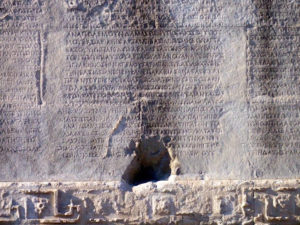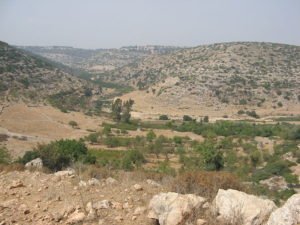Quirinius, Governor of Syria When Jesus Was Born?
Quirinius – if not for the Nativity account in the Gospel of Luke, his name would be all but forgotten. Governance of Quirinius presents probably the greatest challenge to validating the five tight date parameters established by Luke and Matthew for the birth of Jesus of Nazareth.
In his day Quirinius (Cyrenius in Greek) was a famous, powerful Roman Consul, the highest Senate rank achievable.[1] Included in his resume are stints as a provincial governor in Crete & Cyrene, Galatia, Pamphylia, possibly Asia and was a war hero for his military victories – all prior to 4 BC.[2]
Jewish historical views of Quirinius are quite different. To the Jews, he is known as the infamous governor of Syria who in 6 AD imposed a Roman provincial taxation triggering a Jewish revolt.[3] Understandably, the contemporary Jewish reading audience of Luke would easily recognize a reference to Quirinius.
Luke confirms Matthew‘s statement that Herod was King when Jesus was born. Tightening the timeline, Luke adds two more defining parameters bringing the total to four – Caesar Augustus, his census decree, the reign of King Herod plus a celestial star event. Evidence shows all scenarios align with the 2 BC timeframe leaving Quirinius as the X-factor.[4]
LK 2:1-3 “And it came to pass in those days that a decree went out from Caesar Augustus that all the world should be registered. This census first took place while Quirinius was governing Syria. So all went to be registered, everyone to his own city.” (NKJV)
Two observations about Quirinius can be pulled from Luke 2:2. “This census first took place while Quirinius was governing Syria.” Aside from the governance of Quirinius, if there was a first registration associated with Quirinius, “This census first took place…” there had to be a second one.[5]
Indeed, there is a second reference. The Books of Acts, the common author of the Gospel of Luke, makes a second reference to a “census”:
ACT 5:37 “After this man [Theudas], Judas of Galilee rose up in the days of the census [apographe], and drew away many people after him. He also perished, and all who obeyed him were dispersed.” (NKJV)
Bringing clarity in the Greek text, the verse contains a rarely used Greek word noun, apographe, meaning “a register; enrollment.” Muddling the situation, English Bible versions translate apographe using five different words – “census,” “registered,” “enrolled,” “numbering,” and “taxed.”[6]
Comparing the two events, Luke’s registration scenario is benign while the Acts scenario is circumstantially different – it involved an uprising. Neither scenario is associated with a Roman lustrum census that was last taken in 8 BC, according to Augustus’ own documented declaration.[7]
According to secular history, a conundrum is posed because Herod’s death year and Quirinius governing in Syria do not sync with the 4 BC timeline. Evidence now strongly suggests Herod’s death occurred during 2 -1 BC potentially changing the equation.
Unique to the Gospels is Luke’s twice-used word hegemoneuo, a specific form of hegemon. Both words have different definition distinctions, yet are typically translated into English as “governor.”
Greek hegemoneuo means “to act as ruler” as in acting with the authority of a governor, a verb.[8] Root word is hegemon, a noun meaning “a leader, that is, chief person (or figuratively place) of a province: — governor, prince, ruler”[9] Luke and Acts uses the hegemon title reference 8 times and the word is used 19 times in the New Testament.
Just twice and only in Luke does the author exclusively use the verb hegemoneuo. Appearing in very close proximity in the text, the word is used to describe responsibilities of two different rulers, Quirinius and Pilate:[10]
LK 2:2 “This census first took place while Quirinius was governing [hegemoneuo] Syria.”
LK 3:1 “Now in the fifteenth year of the reign of Tiberius Caesar, Pontius Pilate being governor [hegemoneuo] of Judea…” (NKJV)
Pilate was a Prefect and a Procurator in a Roman province appointed by Caesar, not a legate “governor” which required Consul rank.[11] Responsibilities included Roman financial affairs and vested judicial power over life and death decisions, essentially possessing the authority powers of a governor.[12]
Using exactly the same word hegemoneuo, the word is used to describe the responsibilities of Quirinius.[13] In the eyes of the Jews, the Roman distinctions of rank made little difference because both virtually had the same fearful Roman governing authority.
Not alone is Luke treatment of Romans in a governing position in Syria – so did Caesar Augustus and Josephus. Augustus recognized three governing authorities in Syria toward the end of Herod’s reign – two presidents and a procurator.[14]
Caesar, in a letter, instructed Herod to seat three Syrian judges for the murder plot trial of Herod’s two sons. Augustus called out by name Saturninius and Pedanius as the two “presidents” of Syria, and the procurator Volumnius.[15]
“Caesar had ordered the court to be assembled…The presidents set first, as Caesar’s letters had appointed, who were Saturninus, and Pedanius, and their lieutenants that were with them, with whom was the procurator Volumnius.” – Wars of the Jews
A few years later upon Herod’ death, Varus and Sabinus separately rushed to Jerusalem to secure his estate. Josephus identified “Varus, the president of Syria” and Sabinus as “Caesar’s procurator” and “Caesar’s steward for Syrian affairs.”[16]
Josephus also made numerous references to “Saturninus and Volumnius…the presidents of Syria. ” Saturninus was actually the Roman legate governor and Volumnius was the Roman procurator.[17]
Secular history recognizes Saturninus as the legate Roman governor of Syria circa 9-6 BC.[18] Varus was the Roman legate governor from at least 6-4 BC, perhaps into 3 BC and possibly again in 1 BC leaving a complete gap in 2 BC.[19]
Question: who was the other “president” at the time of Herod’s death? Josephus didn’t say.
Independently, several 19th century historians tackled the Quirinus enigma. Not all were in complete agreement with their conclusions and timelines. Their varied research results were in relative agreement on one point – all agreed Quirinius served in a governing capacity in Syria prior to his infamous 6 AD Roman legate governorship.
Some of these historians concluded that Quirinius first governed in Syria sometime during 6-1 BC. More notably, others narrowed the time frame to the years of 3-2 BC.[20]
Two 20th century archeological discoveries of ancient inscriptions may provide the strongest evidence that Quirinius governed twice in Syria. Research by historian expert Gerard Gertoux concluded these two inscriptions identify Quirinius as the governor of Syria during the 3-1 BC timeframe.[21] One called out Quirinius by name…twice:
“Q[uintus] Aemilius Secundus s[on] of Q[uintus], of the tribe Palatina, who served in the camps of the divine Aug[ustus] under P. Sulpicius Quirinius, legate of Caesar in Syria, decorated with honorary distinctions, prefect of the 1st cohort Aug[usta], prefect of the cohort II Classica. Besides, by order of Quirinius I made the census of 117 thousand citizens of Apamea.” – Titulus Venetus inscription (English translation) [22]
Gertoux makes the case that Quirinius took a special census in 2 BC as part of the Breviarium of Augustus. This census could not be referring to the 8 BC lustrum of the Roman Empire exclusive to Rome nor the 6 AD taxation census taken by Quirinius that was exclusive to Judea. Further, he concluded, a census in Apamea would have required the assistance of Judean King Herod.
Multiple historian’s research indicates Quirinius did govern in Syria at some point during the years of 6-1 BC. Archeological evidence narrows the time frame even more.
Does evidence corroborate Luke’s statement that Quirinius governed in Syria at the time of a census registration decreed by Caesar Augustus while King Herod was alive?
Updated December 22, 2023.
This work is licensed under a Creative Commons Attribution-NonCommercial-NoDerivatives 4.0 International License.
REFERENCES:
[1] KJV. Kurenios <2958> Net.bible.org. <http://classic.net.bible.org/strong.php?id=2958>
[2] Gertoux, Gerard. “Dating the two Censuses of Quirinius.” Titulus Venetus (CIL III; ILS 2683). Inscription. p 9. <http://www.academia.edu/3184175/Dating_the_two_Censuses_of_Quirinius> Consuls.” History of Ancient Rome. 2018. <http://www.unrv.com/government/consuls.php> “Senatorial Provinces.” History of Ancient Rome. 2018. <http://www.unrv.com/government/senatorial-provinces.php> “Consul.” Livius.org. Ed. Jona Lendering. 2018. <http://www.livius.org/cn-cs/consul/consul.html> “P. Sulpicius Quirinius.” Livius.org. Ed. Jona Lendering. 2018. <http://www.livius.org/su-sz/sulpicius/quirinius.html> Josephus, Flavius. Antiquities of the Jews. The Complete Works of Josephus. Trans. and commentary. William Whitson. 1850. Book XVIII., Chapter I.1. <http://books.google.com/books?id=e0dAAAAAMAAJ&printsec=frontcover&source=gbs_ge_summary_r&cad=0#v=onepage&q&f=false> Bunson, Matthew. Encyclopedia of the Roman Empire. “Consuls; Crete and Cyrenaica.” <https://archive.org/details/isbn_9780816045624>
[3] Acts 5. Smallwood, E. Mary. The Jews Under Roman Rule: From Pompey to Diocletian. 1981. pp 151-156. <http://books.google.com/books?id=jSYbpitEjggC&lpg=PA151&ots=VWqUOinty4&dq=census%20Syria%20Rome&pg=PP1#v=onepage&q&f=false> Josephus. Antiquities. Book XVIII, Chapters I-IV.
[4] Matthew 2. Luke 1-2.
[5] NRSV. Luke 2. Net.bible.org. Greek text. “protos” <4413>” Lexicon-Concordance Online Bible. n.d. <http://lexiconcordance.com> Smith, William; Wayte, William; Marindin, G.E., Ed. A Dictionary of Greek and Roman Antiquities. 1890. “apographe.”
[6] Acts 5:37. BibleHub. com. lexicon. “582.” n.d. < https://biblehub.com/lexicon/acts/5-37.htm> “G0582.” LexiConcordance..com. n.d. <http://lexiconcordance.com/greek/0582.html> Smith, William; Wayte, William; Marindin, G.E., Ed. A Dictionary of Greek and Roman Antiquities. 1890. “apographe.” <https://books.google.com/books?id=Cu89AAAAYAAJ&pg=PA403&lpg=PA403&dq=greek+word+for+census&source=bl&ots=LM1MjmCiJt&sig=1_yjJgyNxcCcSWZvf0QK69IJuMw&hl=en&sa=X&ved=0ahUKEwjx0oPA04DYAhXo6YMKHebvAEwQ6AEIejAK#v=onepage&q=register&f=false> Bunson, Matthew. Encyclopedia of the Roman Empire. “Censor; Census.” <https://archive.org/details/isbn_9780816045624>
[7] Smallwood. The Jews Under Roman Rule. p. 152. Ando, Clifford. A Companion to the Roman Empire. Ed. David s. Potter. pp 178-179, 186. 2006. Academia.edu. <https://www.academia.edu/649274/The_Administration_of_the_Provinces>
[8] Net.bible.org. Luke 2:1 footnote #5 and Greek text. “hegemoneuo <2230>” Lexicon-Concordance Online Bible. Josephus. Antiquities. Book VIII, Chapter XV; Book X, Chapter IV; Book XIV, Chapters IX, XII; Book XVIII, Chapter VI. Josephus. The Life of Flavius Josephus. n.d. #9, #17. Josephus. Wars of the Jews. Book I, Chapter XXVII.3. Josephus. Against Apion. Book II, #22.
[9] Net.bible.org. Luke 2:1 footnote #5 and Greek text. “hegemon <2232>” Lexicon-Concordance Online Bible. Josephus. Antiquities. Book VIII, Chapter XV; Book X, Chapter IV; Book XIV, Chapter IX; XII; Book XVIII, Chapter VI.. Josephus. Life. #9, 17. Josephus. Wars. Book I, Chapter XXVII. Josephus. Against Apion. Book II, #22. “Pontius Pilate.” Livius.org. Ed. Jona Lendering. 2019. <https://www.livius.org/articles/person/pontius-pilate> “legate.” Encyclopædia Britannica. 2018. <https://www.britannica.com/topic/legate-Roman-official> Carrier, Richard C. “Herod the Procurator: Was Herod the Great a Roman Governor of Syria?” 2011. p. 7. <https://www.academia.edu/1203990/Herod_the_Procurator_Was_Herod_the_Great_a_Roman_Governor_of_Syria?email_work_card=view-paper>
[10] Josephus. Wars. Chapter IX. Josephus. Antiquities. Book XVII, Chapter XI; Book XVIII, Chapter V. “Tiberius.” Livius.org. Ed. Jona Lendering. 2018. <http://www.livius.org/articles/person/tiberius>
[11] “Pontius Pilate.” Livius.org. “legate.” Encyclopædia Britannica. Josephus. Wars. Book I, Chapter XXIV.6, Book II, Chapter VIII, XIV. Josephus. Antiquities. Book XV, Chapter III, Book XVII, Chapters IV & XX; Book XVIII, Chapter III; Book XIX. Chapter XIX; Book XX, Chapter I.
[12] “Procurator.” Livius.org. “Governor (Roman).” Livius.org. <http://www.livius.org/gi-gr/governor/governor.html> “Procurator.” Merriam-Webster. 2018. <https://www.merriam-webster.com/dictionary/procurator> “Procurator.” Jewish Virtual Library. 2008. <https://www.jewishvirtuallibrary.org/procurator>
[13] Net.bible.org. Luke 2:1 Greek text, footnote #5; “hegemoneuo <2230>”; “hegemon <2232>”; “hegemoneuo #2230” (Greek Word Study). (Thayer); “hēgemoneuo <2230>” Lexicon-Concordance Online Bible. n.d. <http://lexiconcordance.com/greek/2230.html>
[14] Ramsay, William M. “Was Christ Born in Bethlehem?” 2010. Biblehub.com. Chapter 11. <http://biblehub.com/library/ramsay/was_christ_born_in_bethlehem/index.html>
[15] Josephus. Wars. Book I, Chapter XXVII. Josephus. Antiquities. Book XVI, Chapter XI. Bunson, Matthew. Encyclopedia of the Roman Empire. “Berytus.” <https://archive.org/details/isbn_9780816045624>
[16] Josephus. Antiquities. Book XVI, Chapter IX; Book XVII Chapters, IX, X. Josephus. Wars. Book II, Chapter II. Bunson, Matthew. Encyclopedia of the Roman Empire. “Judaea.” 2002. <https://archive.org/details/isbn_9780816045624>
[17] Josephus. Antiquities. Book XVI, Chapters IX, XI; Book XVII, Chapter IX-XI; Book XX, Chapter XVIII. Josephus. Wars. Book I, Chapter XXXI; Book II, Chapter II. Antiquities. Josephus. Life. #11.
[18] “Syria.” Regnal Chronologies. Doig, Kenneth F. New Testament Chronology. 1990. Chapter 5. <http://nowoezone.com/NT_Chronology.htm> Schurer, Emil. A History of the Jewish People in the Time of Jesus Christ.1890. <http://books.google.com/books?id=BRynO3W9FPcC&pg=PP1#v=snippet&q=Tiberius&f=false>
[19] “Ancient History Sourcebook: Res Gestae Divi Augusti, c. 14 CE.” Davis, William Steams, ed. 1912. <http://www.fordham.edu/halsall/ancient/14resgestae.asp> Ramsay. Was Christ Born in Bethlehem? Chapter 11. “Syria.” Regnal Chronologies. n.d. <http://web.raex.com/~obsidian/Syria.html#Syria> Schurer. A History of the Jewish People in the Time of Jesus Christ. Volume 1, page 351. Martin, Ernest L. The Star of Bethlehem: The Star That Astonished the World. Chapter 10. <http://askelm.com/star/star000.htm#_edn11%3E%20%3Chttp://web.archive.org/web/20170111193244/http://www.askelm.com/star/star001.htm>
[20] Davis, J. “Quirinius.” Schaff, Philip. History of the Christian Church, Vol. I. n.d. Christian Classics Ethereal Library. “Chronology of the Life of Christ.” “The Census of Quirinius.” pp 101-104. 13 July 2005 <http://www.ccel.org/ccel/schaff/hcc2.i.html> <https://ccel.org/ccel/schaff/hcc1/hcc1.i.II_1.16.html> Ramsay. Was Christ Born in Bethlehem? Chapter 11.
Schaff. History of the Christian Church, Volume I. “Chronology of the Life of Christ.” Chapter 2, Sec 16. Sieffert, F. “Census.” The New Schaff-Herzog Encyclopedia of Religious Knowledge. Vol. II: Basilica – Chambers. 1952. <http://www.ccel.org/s/schaff/encyc/encyc02/htm/iv.vi.ccxxx.htm> Tacitus, Gaius Cornelius. The Annals.109 AD. Book III. Trans. Alfred John Church and William Jackson Brodribb, <http://classics.mit.edu/Tacitus/annals.html> Smith, William. A School Dictionary of Greek and Roman Antiquities. 1857. “Vice’sima.” <https://archive.org/stream/schooldictionary00smituoft#page/n9/mode/2up/search/publicani> “Cilicia.” Livius.org. Ed. Jona Lendering. 2018. <http://www.livius.org/cg-cm/cilicia/cilicia.html> “Cilicia.” UNRV History |The Roman Empire. 2017. <http://www.unrv.com/provinces/cilicia.php> “Cilicia.” Livius.org. Ed. Jona Lendering. 2014. <http://www.livius.org/cg-cm/cilicia/cilicia.html> Mommsen, Theodor. The Provinces of the Roman Empire from Caesar to Diocletian. Volume 1. 1887. Chapter VIII., pp 347 – 397. <http://books.google.com/books?id=_WAKAAAAIAAJ&pg=PP1#v=onepage&q=asia%20minor&f=false> Boak , Arthur Edward Romilly. A History of Rome to 565 A. D. 1921. p 277. 2010. <http://www.gutenberg.org/files/32624/32624-h/32624-h.html> Schurer. A History of the Jewish People in the Time of Jesus Christ. Volume 1, pp 351-354. “Syria.” Regnal Chronologies. “Varus, Quintilius.” Jewish Encyclopedia. 2011. <http://jewishencyclopedia.com/articles/14647-varus-quintilius> Doig. New Testament Chronology. Chapter 5. Schurer. A History of the Jewish People in the Time of Jesus Christ. Volume 1, pp 352-353. “List of Roman governors of Syria.” Wikipedia.com. 2018. <http://en.wikipedia.org/wiki/Roman_governors_of_Syria> Gertoux. “Dating the two Censuses of Quirinius.” p 8. Bunson. Encyclopedia of the Roman Empire. “Consuls.”
[21] Gertoux. “Dating the two Censuses of Quirinius.” pp 3-5. Gertoux, Gerard. “Dating the death of Herod.” 2015. p 1. <http://www.academia.edu/2518046/Dating_the_death_of_Herod>
[22] Gertoux. “Dating the two Censuses of Quirinius.” Titulus Venetus (CIL III; ILS 2683). Inscription. p 4.



